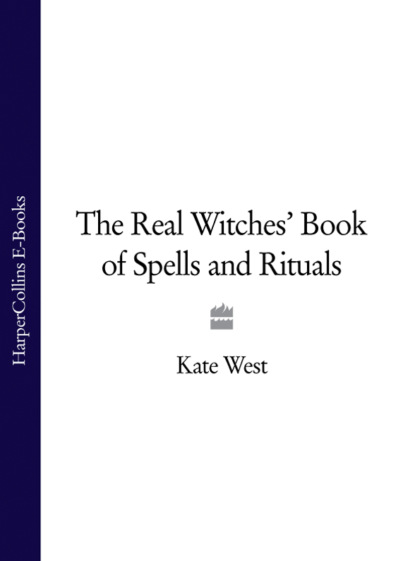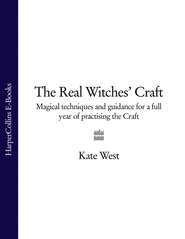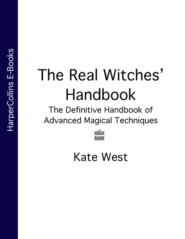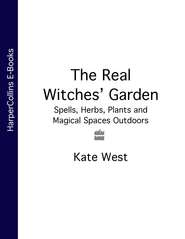По всем вопросам обращайтесь на: info@litportal.ru
(©) 2003-2024.
✖
The Real Witches’ Book of Spells and Rituals
Автор
Год написания книги
2018
Настройки чтения
Размер шрифта
Высота строк
Поля
It is sometimes very hard to work magic for yourself and for those close to you, not because of any natural laws against it, but simply because your focus and concentration will not be all they should be. It is hard enough to remain focused on dressing a bad cut which is bleeding heavily if this is someone you care for deeply, let alone bringing the elements into balance, raising energy and working magic. Similarly, if you have pressing physical or emotional concerns in your own life, you will find it almost impossible to become mentally and physically prepared for any kind of magic unless you can put them aside. If those very concerns are to be the focus of your magic then you will find it nigh on impossible to put them aside as well as focus on them at the same time! In these circumstances you need to find someone else, who you trust implicitly, to work magic for you.
Love Magic
This is an area where magic can go wrong even if it works perfectly! If you work magic to make someone love you, sooner or later you will be wondering whether it is you they love or the spell which is working. If you work this kind of magic for someone else you will then be perceived as being responsible for their relationship, a bit like being the instigator of an arranged marriage where one partner is not aware that it has been arranged. At the least you will find yourself drawn into every hiccup in the relationship, at the worst you may find yourself being blamed for every argument or problem, or even the fact that person B did not turn out to be exactly what person A had hoped for some ten years down the road! If you must get involved in relationship magic then stay with some of the less direct options, such as increased confidence, the opportunity to meet a person with whom you can be happy, and so on.
You Fail to Pay for What You Have Received
Magic should be seen as an exchange of energies. Whilst you put some of the energy into the spell, much of it comes from outside of you, from the elements, the Goddess and the God. This energy should be repaid. This is not to say that you are going to give them money, but rather that you should do something to repay the energy. This should be something which expresses your thanks, whereby you put your energy back into the land, or into honouring the Goddess and the God. Tending growing things, be they plants, pets or children, is one way. Creating something in honour of the Divine is another. But whether you choose to trim your hedge, clear litter from a local park, take your child to the swings, or paint a picture, it should be done with the intent of giving thanks to the Goddess and the God and to the elements. Every act of magic should be repaid in some way, and as soon as possible, it is a part of making the magic work. It is not a question of a bargain where you will pay for it if it works; it is more a question of giving thanks for being able to access the energies and for the attention of the elements, the Goddess and the God. Should you fail to repay the energies, your magic will decline over time and, in due course, fail.
Having looked at the ways in which magic does and doesn’t work, let’s move on to some of the Rituals into which we put our spells and magics.
THREE CASTING THE CIRCLE, AND OTHER FREQUENT RITES (#ulink_2d6663d8-5585-5eed-9189-76a68a176435)
As I said in the last chapter a Ritual is usually constructed out of several separate pieces called Rites. Many of these are performed in the same way and to avoid repetition later in the book I have put these basic Rites into this chapter, so that you can refer to them whenever you need to.
Basically, there are two kinds of Ritual; Esbats or working Rituals where magic is performed, and those which are celebratory, for instance Sabbats and Rites of Passage. In the former, energy or power is raised to fuel an act or acts of magic, and therefore a Circle should be cast. As the latter are celebratory it is not necessary to raise power and therefore to actually cast a Circle. This division between Esbats and Sabbats is not fixed as it is possible to work magic at the Sabbats (so long as it fits with the theme of that Sabbat), in which case you will need a Circle. Also, you can work magic at other phases of the Moon, and these Rituals will also need a Circle. Similarly, you may choose to hold a celebration, perhaps a Wiccaning or Handfasting, at an Esbat, in which case you will not need a Circle. Initiation Rituals, whilst celebratory, are also magical workings and will need a Circle and the raising of energy, even though you are not working any spells as such.
There is also a difference between working on your own as a Solitary and working in a group or Coven. In the former you have only yourself to prepare, in the latter you have others to consider and communicate with. In the former you can work largely in your head, silently and perhaps sitting on the floor. In the latter you will need to speak out loud and probably move around one another. You will also find that it is helpful to have more tools and visible objects when working with others, as these visual keys help to ensure that everyone is focused on the same thing at the same time. When starting out as a Solitary you may find that these same visual keys help you to retain focus, as you will have much to remember as well as keeping your intent clear.
THE WORKING SPACE
This is the room or area you intend to work in. Witches do not need purpose-built temples or even a special room in the house as they can create their Sacred Space wherever they wish to. The area in which you are going to create that space is your working space. It should be spacious enough for you, whether you are one or many, to move freely in, and indoors this may mean moving some of your furniture. Again, if it is indoors it should be clean, tidy and free from too many distractions, as you not only need to focus but you are also inviting the Goddess and the God, so try to make it somewhere you feel they would come to! If outdoors you need to ensure that you are neither trespassing nor are likely to be disturbed. If you are Solitary, or few in number, then you should be doubly careful that you are not going to be accosted by passers-by wondering what you are up to. You also need to ensure that it is safe, with no hidden cliffs, rabbit holes, broken glass or rusting metal to be discovered by the unwary. The working space is generally considered to be circular, although you may need to compromise somewhat if you are short of space or have a non-circular area to work in.
Whilst it would be nice to be able to align your working space with the points of the compass, so that your North really is in the direction of North, it is not always possible. In this case try to align as closely as you can, whilst still being able to use the space in a reasonable manner.
THE ALTAR AND WORKING TOOLS
Here I am going to give a fairly basic Altar layout with a selection of the tools most commonly placed on it. There are other ways of setting the Altar and a great many other tools which may be placed on it. Some Witches like to have all their working tools to hand, others prefer to have only those which they are going to use. Whichever course you choose it is as well to check the tools against your Ritual notes to ensure that you have everything which you are going to use, before you Create your Sacred Space.
Working tools do not have to be expensive or bought from specialist suppliers, you can select ordinary everyday objects for many of them, or make your own. It is, however, preferable if your working tools can be kept separate from other household items and their use reserved for Ritual and magic as, with use, they will build up their own reservoir of magical energy.
ALTAR
The Altar is simply the surface on which you place everything you will need to work with. If you are on your own and intend to work sitting on the floor, then it could be as simple as a small cloth placed in front of you, although do ensure that if you are using candles you can keep them safe. However, most Witches prefer to use some kind of table or other surface of adequate size at a convenient height. When working outside you may like to use a convenient rock or tree stump, or to take a box with you for the purpose.
The Altar can be placed in one of a number of parts of the Circle:
* The Centre, to allow you maximum use of the circumference. This is especially useful when working indoors with limited space and a large number of people. This is less convenient if you intend to Circle dance, or to have any other central feature such as a cauldron or fire.
* The East, which is the starting point of the Circle, as it represents Air and thought. This does mean that when it comes to actually Casting the Circle you will have to move around nearly the whole circle (as you always move Deosil in Circle) before commencing to actually Cast it at the North-East.
* The North-East, or point of entry. This is fine unless and until you wish to have someone come in at the point of entry, as in Initiations for example.
* The North, or point of power. This is where I prefer to have the Altar.
Whichever you choose, it is important that you and everyone else in the Circle know at which point the Altar is set. Generally speaking it is best to choose your Altar point and then keep that for all your Rituals in order to avoid subsequent confusion!
ALTAR CLOTH
It is usual to cover the Altar with some kind of cloth, kept especially for the purpose. This not only protects the surface from any spills but also helps to mark the change of use from daily to Ritual. An Altar cloth does not need to be particularly fancy, or bought from a specialist supplier, but it does need to be kept clean and unrumpled. You may choose to have different cloths for each of the Sabbats and others for different kinds of magical working, or you may simply have the one for all Craft purposes. Whichever you choose is up to you, there is no right or wrong choice.
REPRESENTATIONS OF THE ELEMENTS
* Earth. Earth is usually represented by salt in a small container. Some consider that it should be rock salt rather than sea salt, but again it is what feels right to you that is most appropriate. However, you could also use soil, a small rock or pebble.
* Air. Air is generally represented by incense, which may be of a scent to complement your magic or the festival. Incense comes in sticks, cones and loose, but whichever you select you will need to ensure that you have a fireproof stand or container to place it in or on. Please ensure that this container does not itself become so hot that it could set fire to the underlying surface. If using loose incense you will also need ‘self-igniting charcoal’ on which to burn it, and probably some kind of tongs to hold that charcoal whilst setting it alight. Loose incense is usually burned in a container called a Thurible (see Appendix 2, Terms and Definitions). Please consider the effects of burning incense on any smoke detector you may have fitted! You will also need matches. If you cannot burn incense you could substitute essential oil in an oil burner, or even a feather to represent air.
* Fire. Fire is usually represented by a candle, in which case you will need a safe candleholder. You may also like to have a snuffer with which to extinguish the flame later on. If you cannot have a naked flame then a small faceted crystal is a good alternative.
* Water. Water is generally represented by a small bowl or dish of water. Some purists like to collect rainwater for this purpose, rather than using the chemically treated stuff that comes from the tap. As a substitute you can have a seashell or other object which represents water.
THE GODDESS AND THE GOD
It is usual to have something to represent the Goddess and the God, and hence the Spirit. This could be statues of your chosen Deities, candles – one for each or one for both, or other objects which you feel encapsulate their Spirit on the Altar.
ALTAR PENTACLE
There are many fine Pentacles available today, but you can just as easily create your own in salt (if you have a steady drawing hand) or paint one onto a flat stone or circular board. If you were to look closely at mine you might notice a distinct similarity to a circular breadboard! In addition to the Pentagram (see Terms and Definitions), other symbols of the Craft may also decorate the Pentacle.
ATHAME
This is the Witches’ blade. Strictly speaking, you do not need an Athame, as anything you cannot invoke with a finger you will not be able to invoke with the knife! Many consider that the Athame should be placed on the Altar, however these days many Witches will wear theirs in a special holder or scabbard which hangs from a cord at the waist. Certainly, if you are working in a group it is easier to have your Athame at your belt than it is to have 10 to 20 placed on the Altar.
WINE AND CAKES
Most, if not all, Rituals will contain the Rite of Wine and Cakes, so you will need a Chalice with wine in it (or fruit juice if you cannot or should not drink alcohol). If there are many of you, you may need to have the bottle on hand for topping up. Red wine is usual, although on some festivals and other occasions you might feel something else is more appropriate. Also, you should have a plate with enough biscuits for everyone in Circle plus one (for the offering). These can be specially made, or you can buy ordinary small biscuits. An alternative is pieces of fruit.
NOTES OR SCRIPT
This can be a short note to remind yourself of the purpose and steps of your Ritual, or it could be a whole ‘script’ in a special book, supported in a book holder, which everyone in Circle can access if the need arises. This latter option is more often used in complex Rituals which are performed infrequently, such as Handfasting.
AND ALSO
There are many other tools which can be placed on, or by, the Altar for specific purposes:
* Boline, the white-handled knife used for cutting and carving, etc.
* Sword, sometimes used for casting the Circle.
* Cauldron, for containing fire to burn things, or water for scrying.
* Besom, or broom for sweeping the Circle and for use in Handfasting.
* Wand, sometimes used for invoking Air and Water.
* Scourge, representing the sorrows of life and used in some Covens to maintain and enforce discipline.
* Cords, representing self-control and discipline and used in cord magics.









